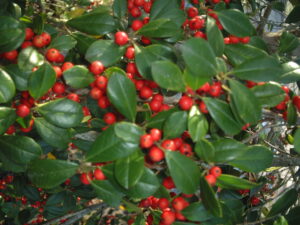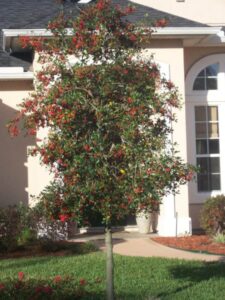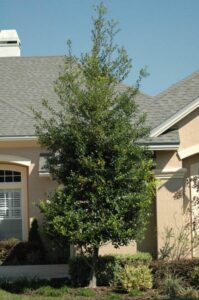S & J Nursery’s Guide to Growing
East Palatka Holly
in The Northeast Florida Landscape
( Ilex attenuata ‘East Palatka’)
NOTE: Availability on this species has become extremely limited as many large commercial growers have seemingly switched to the ‘Eaqgleston’ selection of ilex attenuata
East Palatka Holly Preferred Exposure:
– Native to North America the East Palatka Holly was found growing near Palatka
Florida and is cultivated for its consistent growth habit and abundance of bright red berries on this female only Holly tree.
East Palatka Holly Preferred Exposure:
– East Palatka Holly trees will tolerate both full sun and full shade equally well in the North Florida | Jacksonville | St. Augustine area landscape. They will tend, like other Holly cultivar to have more berries when planted in exposures with more sun.
East Palatka Holly Foliage | Bark:
– Although this tree is prized for its abundant berries, the East Palatka Holly’s foliage is note worthy in and of itself. The light green leaves add a sense of freshness to the landscape, like the color of grass after a good hard rain.
– Bark of the East Palatka Holly is a light pale often mottled whitish grey.
– Although these trees are most often seen sheared and shaped heavily when planted in the landscape, they have a certain grace to them when allowed to grow in their natural form and not sheared back annually. The tree will open up in the center to expose branches and have a beautiful almost weeping habit with the heavily laden branches drooping downward full of berries each winter season.
East Palatka Holly Soil Preference / Salt tolerance:
– Characteristics similar to most species of Holly trees, the East Palatka Holly
will prefer rich, slightly acidic well drained soils.
– Salt tolerance moderate
East Palatka Holly Size Variance:
– The East Palatka Holly can reach sizes of 30-45’H | 10-15W
 East Palatka Holly (Ilex Attenuata) Growth Habit:
East Palatka Holly (Ilex Attenuata) Growth Habit:
– Upright columnar growth habit and dense fully foliated branches, the East Palatka Holly tends to be narrow taller than it is wide and gradually widening from top to bottom in a Christmas tree
form.
East Palatka Holly Growth Rate:
– The East Palatka Holly has a moderate growth rate, faster than what is typical of the species.
East Palatka Holly Bloom:
– Small white inconspicuous flowers in clusters in summer are followed by an abundance of berries in the fall / winter season that are favored by birds.
East Palatka Holly Water Requirements:
– Water well during the establishment period and any time after that when you are trying to get your Holly to flush new growth or when attempting to correct a nutrient deficiency in the soil. East Palatka Holly trees are drought tolerant once established in the landscape.
Butterfly or Bird Attracting:
– Birds love the berries produced by the East Palatka Holly in the winter months in the North Florida | Jacksonville | St. Augustine area landscapes.
Best Uses For East Palatka Holly in the North  Florida | Jacksonville | St. Augustine area Landscape:
Florida | Jacksonville | St. Augustine area Landscape:
– East Palatka Holly trees are an easy maintenance option when a narrow landscape accent is needed due to lack vertical space.
– Drought tolerant, and virtually pest free the East Palatka Holly is ideal
for commercial landscapes that will receive minimal maintenance, excellent street or parking lot area tree.
– The East Palatka Holly also makes a great landscape specimen tree that will require little effort on your part to maintain its beautiful form.
– Prune branch tips each winter for Christmas season decorations that will last for weeks, the more you prune for decorations, the prettier your holly tree will be next year!
Care of East Patoka Holly:
– Water every day during the establishment period. See watering your newly planted trees for more information. East Palatka Holly trees will be drought tolerant in the landscape once established and require little in the way of maintenance once planted into the landscape.
-They will need good water during the establishment period and supplemental irrigation when attempting to add soil nutrients or after pruning to help flush new foliage.
– Provide a 1 ft diameter circle of mulched area where grass is kept from growing for each inch of caliper (or diameter) of trunk measured 4 inches from the ground level.
– Fertilize each spring with a mixture of Milorganite or ‘Green Edge’ and a slow release poly coated plant food such as Osmocote for acid loving plants or Stay Green general purpose plant food, sprinkling the fertilizer around the mulch circle underneath the foliage of the tree

